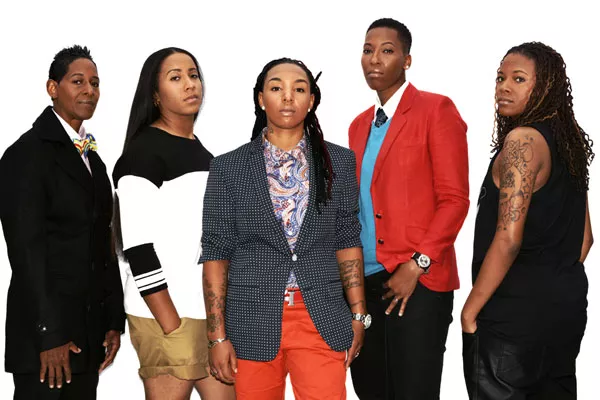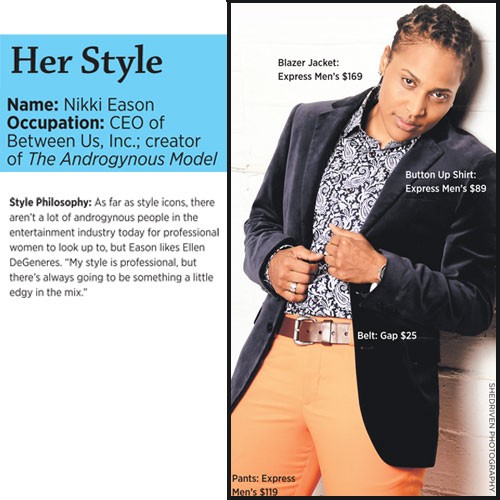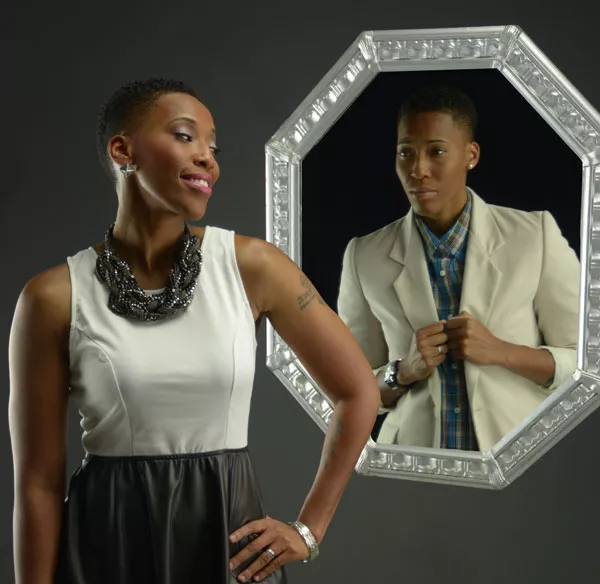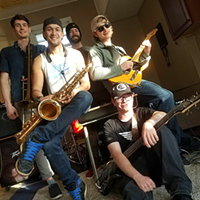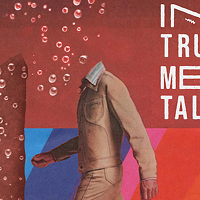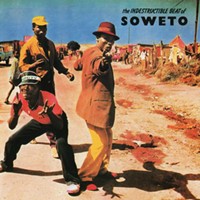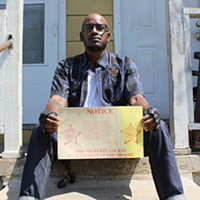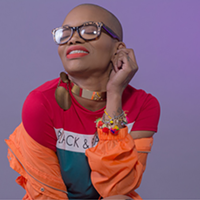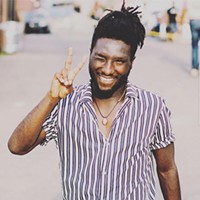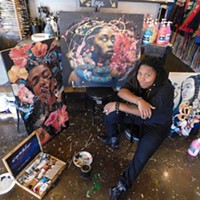Girls will be boys in The Androgynous Model
Web show finds fashion's middle ground
By Emiene Wright @emienewrites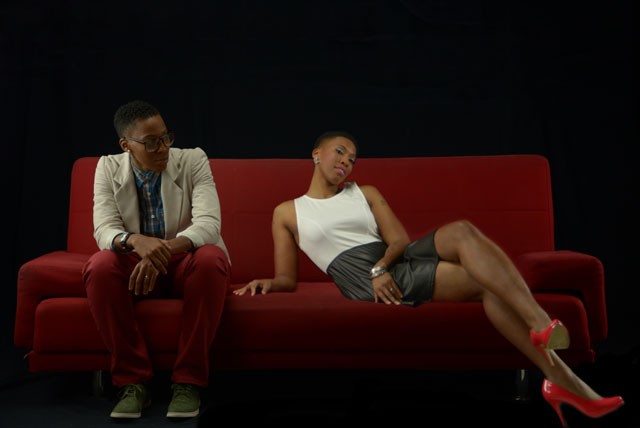
Androgynous Model contestant Sarah 'Supa' Stephens and, well, Androgynous Model contestant Sarah 'Supa' Stephens
The first time Sarah "Supa" Stephens wore pants outside of a basketball court, she was 16 years old. The gangly, brown-skinned girl who wore dresses every day furtively jammed a pair of her older brother's jeans into her bookbag and changed clothes at school, in the girls' bathroom.
"My style was completely boyish: throwback jerseys, fitted caps and Timberlands," she says now. "I probably used to look a mess. But it was a liberating act.
"It's so hard for kids, because their mentality isn't fully developed, to tell their parents, 'Mommy, I love boys' clothes and I feel even more beautiful when wearing them,'" Supa says. But not being able to express the feelings won't make them go away. "In men's clothes, I feel so comfortable, so free. I can walk in heels, I can dress very feminine, but it's not what I prefer. And I'm not trying to be a man. I love to be pretty, throw on some eye shadow."
Supa identifies herself as androgynous, or possessing an equal share of male and female characteristics. She's one of the contestants on The Androgynous Model, a Charlotte-based Web series that aims to expose watchers to the feminine spectrum of androgyny. The tagline is "Be you, because that's what you were born to do."
Terena Starks, Emily Cruz, Melody "Melo" Williams and Trina Muller (from left to right in photo above) are also competing on the show. Similar in concept to the fashion reality show America's Next Top Model, Androgynous Model hopefuls compete in style challenges and photo shoot spreads for cash prizes and to be the face of Between Us Inc. talent agency. Contestants' first style challenge, taking place Nov. 16, is to make the world their stage at the corner of Trade and Tryon streets, giving their fiercest face and walk to a public audience. An open forum in a Bible-belt town could draw hecklers, but that's a chance Nikki Eason, creator of the show, is willing to take.
"They have to show grace, even under potential fire," Eason says. The first photo shoot has already taken place, at Dupp&Swatt, the hyper-eclectic boutique, art gallery and event space in NoDa, and the winner of that shoot will be announced on an upcoming episode. The five competing candidates range in age from 40-something to 19, and Eason says the show uses local photographers, stylists, designers and makeup artists to promote a swath of Charlotte talent.
Besides publicizing the models, another of the show's stated purposes is to shed light on what androgyny is and is not. For example, androgyny is not synonymous with homosexuality. It has little to do with sexual preference at all, but rather is about gender presentation and manifests in how one dresses, stands, sits or walks.
Originally from Hampton, Va., Supa defines her fashion style as preppy with a twist; she mixes blazers and cardigans with dramatic eye shadow and other makeup. Even in combat boots and a bowtie, she'll layer in a strand of pearls for a surprisingly sophisticated effect. She laughs when asked if she enjoys toying with people's preconceived notions.
"I don't do it on purpose. It's definitely me. I can wear skinnies and heels with a nice blouse one day, and the next day men's jeans and bowtie. I'm not trying to be confusing." With her flawless skin and chiseled cheekbones, the statuesque beauty looks born to the runway, but she says she wasn't always confident enough to have tried out for a model show. "I'm proud of how far I came, because the thoughts that used to go through my head were hard to deal with. When you stop worrying about what people are saying about you or how you look, you get more clarity on your identity."
There are many examples of androgyny in American culture, stretching back over a century, particularly in the entertainment industry. During the Harlem Renaissance of the 1920s, Gladys Bentley was a popular jazz and blues singer in Manhattan nightclubs. She often performed in white tie and tails, and flirted outrageously with the women in her audience. She refused to let the barriers of racism, sexism and homophobia restrict her from developing her own distinct jazz style.
Another performer, Billy Tipton, was a popular jazz singer during the 1950s and 1960s; she influenced jazz greats such as Nancy Wilson. Tipton actually lived her life as a man; nowadays, she would have been considered transgendered. Reportedly, even her children did not know that she was a woman.
Back in the early 1980s, this writer's own first encounter with androgyny was a televised video of Grace Jones. It was striking in a couple of ways. First off, the singer was black. To clarify, she was blaaack — a shade you rarely see on women in TV now, and never, ever back then. Her hair was cut down in the angular shape called a box fade. And she was sexy — not in the mincing, don't-you-want-me way that girls are usually presented. In a men's tuxedo jacket, sans shirt, her long, lean body seemed all taut muscle — none of the racetrack curves I'd been taught make a woman's figure desirable. Grace was completely transgressive, singing "I Need a Man," but my 7-year-old self didn't believe that for a second. She was terrifyingly beautiful, yet she didn't fit into any previous mold I had known for femininity. It exposed me to a worldview I had never seen in my urban, Southern neighborhood. Apparently, that's by design.
"Androgynous women of color are living their lives on their own terms," says Sonya Ramsey, associate professor of history and gender studies at UNC-Charlotte. She says the context in which women defy gender norms can differ, and race is a factor. During slavery, the majority of black women were forced to labor alongside black men, doing the same backbreaking fieldwork. This was in direct opposition to the era's prevailing sexist ideas of women's capabilities, so to justify the exception, white society cast black women as animalistic and masculine — not "true" women at all. Following Emancipation, an African-American middle class evolved and, hungry for mainstream acceptance, adopted many of the same sexist ideologies. African-American "ladies" were refined, gentle and while not helpless, definitely in need of the chivalry and protection of men, the same as their white counterparts.
"The adoption of masculine or androgynous style by women of color can be framed as both an act of defiance to society's definition of femininity and a rejection of the black community's politics of respectability," Ramsey says via email. Black women who dressed in a masculine manner were seen as upholding the old stereotype, an embarrassment to the race. They were largely pariah, having little sanctuary in either mainstream or African-American society — a risk that could carry very real consequences. You could lose your job or your family. Walk past the wrong group of men, white or black, and you could lose your life.
Eason, creator of the show, wants people to understand that being androgynous is not a threat, and it's an expression of self, more so than sexuality. "There are women who love men's clothes and aren't LGBT at all. I love men's clothing, how it fits, but it's not about being manly or wanting to be a male, that's not me at all," she says. "I'm a woman; I embody my curves."
The 29-year-old Charlotte life coach began modeling in her early 20s, wearing neatly tailored men's clothes to casting calls. She says she simply likes the look of a feminine form in masculine clothes — she finds it makes a statement. And yet, "I've never seen a woman on the cover of male-dominant magazines wearing the designer's clothes. I wondered, why not?"
Despite agents complimenting her look, she rarely got a callback, and she had an inkling why. "I always wanted to model male clothing, as opposed to women's. I wanted to be the face of Michael Kors, Sean John and Polo Ralph Lauren, but I wasn't being accepted," Eason says. "I'd go to casting calls and they'd ask if [I] really preferred men's clothes to women's. I was like 'Yeah, I didn't come in heels.' I just got tired of it."
Eason decided to step outside of the box and created The Androgynous Model show this year to help promote the androgynous aesthetic. Androgyny is more common than people realize, she says. "That comment you sometimes hear directed at women in relationships, 'Oh, you think like a guy' — that's a form of androgyny, too."
She characterizes her style as "professional, but there's always going to be something a little edgy in the mix. I love a lot of colors, I color-block a lot in ways people wouldn't normally put things together. I wear bowties, ties, suits, I love blazers." She has been known to pop bright blue tees under a slim-fitting, navy, trimmed tuxedo jacket, or pair a pinstriped, purple button-down with a dark suit.
She's a regular shopper in the men's section of Express, Guess, H&M and Kenneth Cole stores, but the welcome is not always pleasant. "When I come into stores and I'm trying to look for clothes, some [sales] reps are not quick to help me, or they try to shepherd me to women's section," Eason says. "This is my money — I decide how to spend it."
She has always favored suits to skirts, as far back as her childhood in Greenville, S.C. "People always thought I was a little boy when I was a kid. I used to get so mad!" she says. Her mom had to force her to wear dresses and tights, but flannel and jeans were more customary.
Supa's background differed considerably. "My upbringing was very religious. We were Holiness," Supa says, referring to the charismatic yet strict Protestant sect. "I'd never seen my mother wear pants, makeup, jewelry, nothing."
Although Supa wore dresses every day and was comfortable with her femininity, as a young tomboy she knew there was something different about her. "Growing up with lots of female cousins, I was always the dominant one. I always had dominant characteristics ... I wore dresses and I'm sitting like a ballplayer. I remember dating a guy, I think I was 14, and he broke up with me because I was too tall and he hated the way I walked."
That feeling of being different left scars, especially when Supa's father died when she was 10. She struggled to fit in with a crowd and spent a lot of time alone as her mother raised her and her two brothers. Money was tight and kids at school were cruel to a tall, sheltered church girl who couldn't go to parties or the movies or do many other things considered "of the world" to her religion.
"I dealt with a lot of bullying because of my height and the way I dressed. We couldn't afford name-brand shoes and whatnot. I was teased a lot. But I'm very grateful for everything I went through," Supa says. "I felt ashamed because I wasn't like the other girls. Boys didn't like me, I wasn't the pretty girl. I just wasn't it. It bothered me for a long time. I knew God had blessed me with so many gifts: playing the piano, singing, writing talent. But being a teenager, you wanted what other girls had. You wanted the popular boys to like you, to be told you were pretty."
Even though she'd been dressing androgynously since 16, Supa didn't find her true style until freshman year of college. She upgraded from the throwbacks to bowties and v-necks, and really came into her own when she cut off her hair. She still dresses feminine when it suits her, but she feels men's clothes are of higher quality and showcase her uniqueness. A budget fashionista, she shops thrift stores for blazers, factory stores like Burlington and K&G for bowties, and chains like Marshalls, Kohls and Express Men. Sometimes she'll have blazers tailored, but not the pants. That's the one concession she most often makes to feminine items.
"I'm a sista," Supa says. "I do have curves, I do have hips, so I wear women's dress pants with male dress shoes, a collared shirt, nice tie and vest and it all comes together. Pretty much I just mix and match."
And now that she's embracing her own beauty, she says, not a day goes by that she doesn't get compliments. Luckily, her family has always been supportive: Her brother would help her pick out looks, and when she began openly sporting an androgynous style, one cheerleader she hadn't been expecting stood up the strongest.
"My mother always told me I was beautiful, but when she saw me dressed in a masculine way, she'd say — in her country way — 'Girl, you sharp. You clean, Sara Jean.' She liked it even more so than when I was in a dress."
Even in the face of social pressure, the devout churchgoer fired back when church members began gossiping about Supa's androgynous look. "She wasn't having it," Supa recalls. "She told them, 'I love my daughter, she's gone to college and lived internationally, and I have nothing bad to say about her.'"
Already, The Androgynous Model has attracted attention from Atlanta, New York, Latin America and as far away as Germany, a fact that Eason says confirms she is on the right track. Besides Eason, there are three other judges: Octavia Lemon is CEO of Genesis, which holds fashion events to raise money for cancer patients. Shanika Latimer is a stylist and fashion blogger for AndrogynousStyle.com, and Davita Galloway owns Dupp&Swatt.
"I feel like she's starting something that somebody else probably was afraid to do," Supa says of Eason's project. "It's groundbreaking. She's started something that's allowing women, little girls, teenagers, whoever, men, boys, that's allowing us to embrace our true selves."
The winner of The Androgynous Model won't be chosen simply based on her performance in front of a camera and her professionalism, but also how she plans to use the platform to inspire change. "When God gives you that platform, what are you going to do with your voice?" Eason asks.
Supa hopes that any little girls who might watch the show online will take away courage. "Know that it's OK to be different. It's OK to be stared at. It's OK to not look like the other girls. It's OK to stand out. Be comfortable and love who you are. It's OK that you might be misunderstood. That's OK."
The next episode of The Androgynous Model goes online Nov. 1. Visit www.AndrogynousStyle.com or search The Androgynous Model on YouTube.
Here's a promo of the show:
Speaking of...
Latest in Cover story
More by Emiene Wright
Calendar
-
An Evening With Phil Rosenthal Of "Somebody Feed Phil" @ Knight Theater
-
Kountry Wayne: The King Of Hearts Tour @ Ovens Auditorium
-
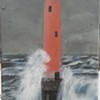
NEW WINDOW GALLERY-Pat Rhea-ACRYLIC PAINTINGS-April 05-30 2024 VALDESE, NC 28690 @ New Window Gallery/Play It Again Records
- Through April 30, 12 p.m.
-

Trap & Paint + Karaoke @ Zodiac Bar & Grill
-

LIVE MUSIC FRIDAYS!!! @ Elizabeth Parlour Room
-
Susan Brenner Examines Upheaval While Celebrating Trees
Chaos and beauty
-
Fall Guide: Upcoming festivals, comedy shows, visual arts events and more
-
Failure To Communicate
Worthy play could use more nuance

